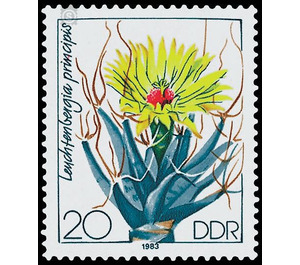Commemorative stamp series - Germany / German Democratic Republic 1983 - 20 Pfennig
Theme: Flora
| Country | Germany / German Democratic Republic |
| Issue Date | 1983 |
| Face Value | 20.00 |
| Color | multi-colored |
| Perforation | K 14 |
| Printing Type | Rotogravure 2 |
| Stamp Type | Postage stamp |
| Item Type | Stamp |
| Chronological Issue Number | 2546 |
| Chronological Chapter | GER-DDR |
| SID | 733439 |
| In 20 Wishlists | |
From cactus cultures of the GDR With the illustrations of cacti, the Ministry of Posts and Telecommunications of the German Democratic Republic publishes six multicolored special postage stamps. Special cancellations from June 21st to August 20th, 1983 Cacti - attractive colors for insects In the case of cacti, the pollination of the flowers, which is vital for the preservation of the species, is usually done by insects or hummingbirds. From the thickets of the shrubs, the cacti with their mostly white flowers rise up to a height of 18 meters and stretch their pistils towards the pollinators. Often there are climbing nightbluers, which shine high above the leaves of the trees. It is different with the low ball and wart cacti, they attract by flying colors of the flowers or thorns, sometimes also by sweet smell of the gland excrements the flying and creeping pollinators. 20 Pfennig value: Leuchtenbergia principis Quite apart from the spherical shape Leuchtenbergia principis is designed, which resembles a ball cactus rather one of the agaves between which it grows. It has upstanding triangular warts, which carry paper-thin, straw-colored bast threads at the upper end. Their buds appear first in the middle below between the youngest, still short warts, with which they gradually grow out taller, to unfold like a plate-like broad. The Leuchtenbergia was described in 1848 by the botanist Sir William C. Hooker and got its name after the plant friend Prince of Leuchtenberg, a stepson of Napoleon I.


